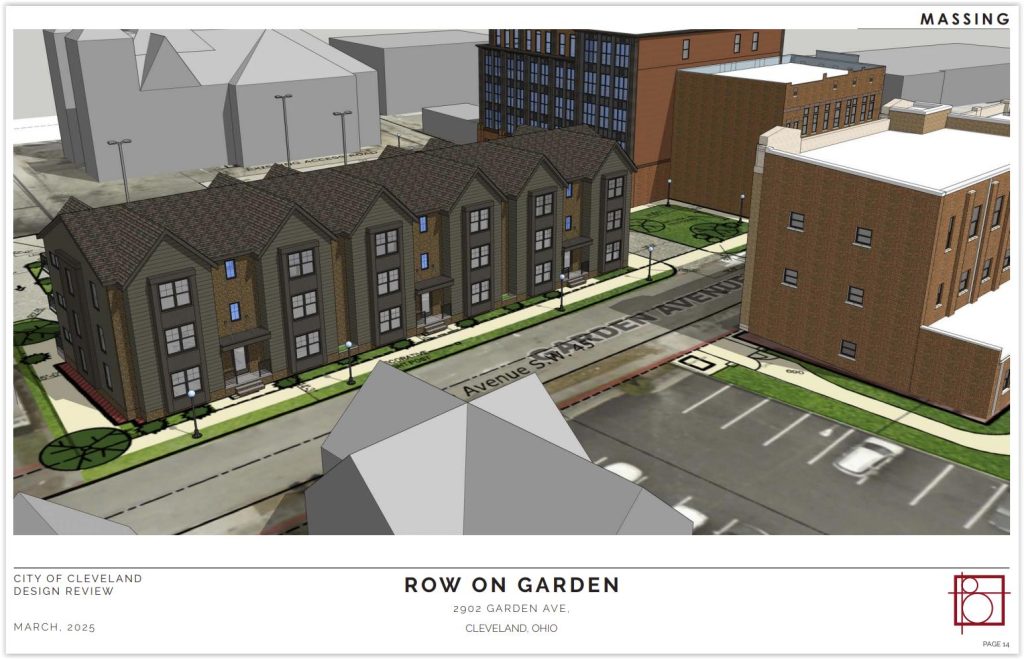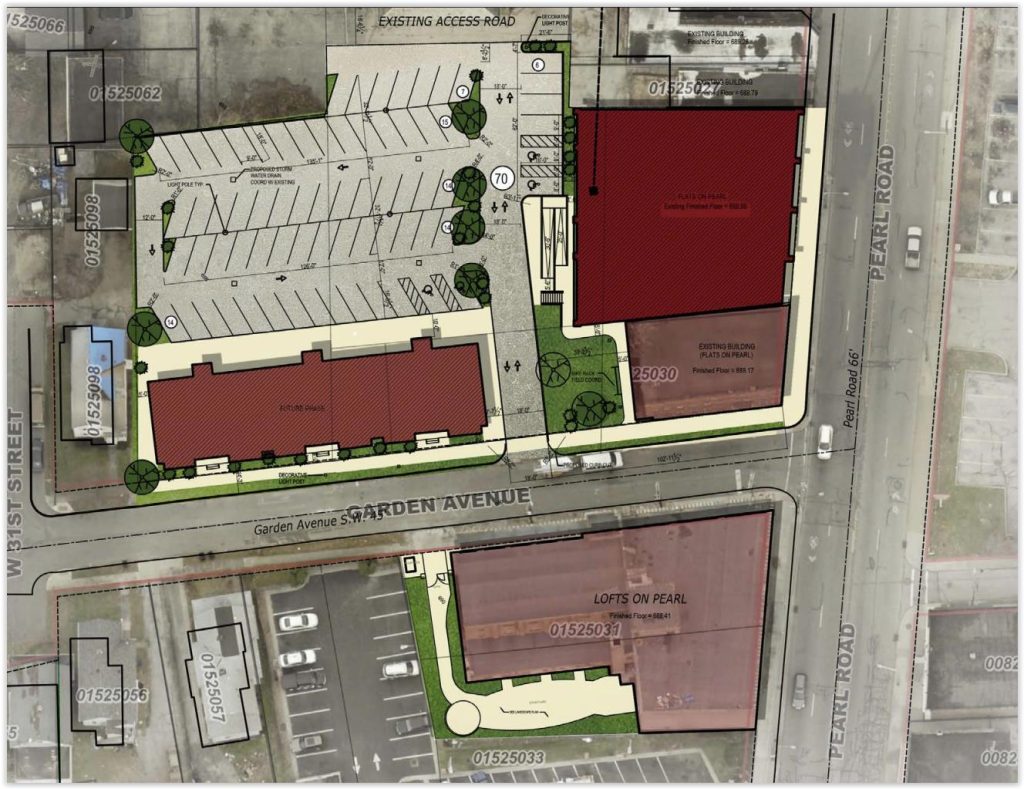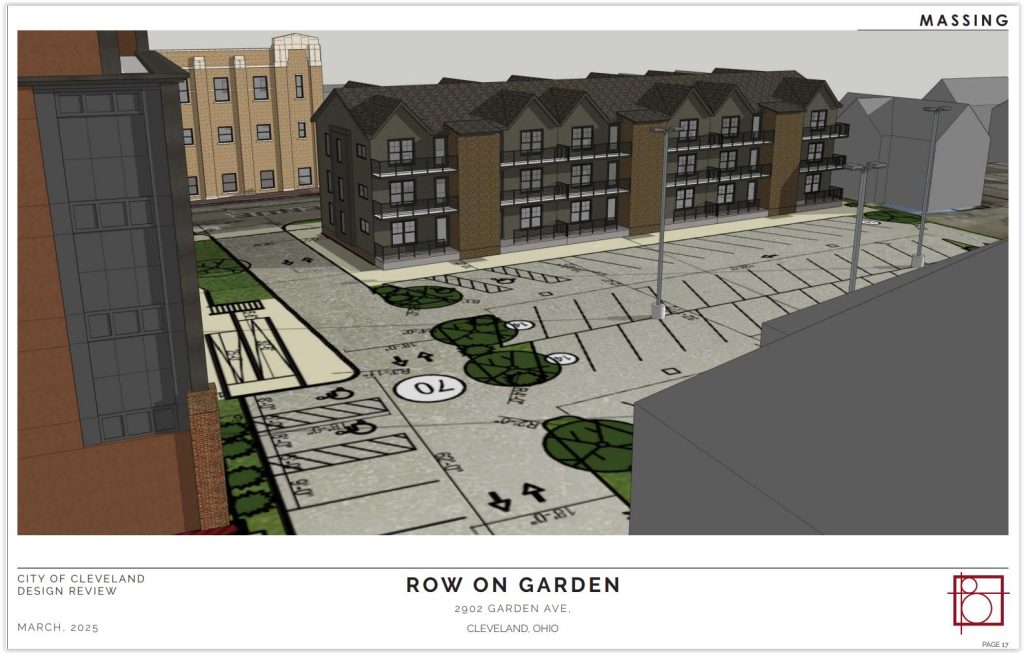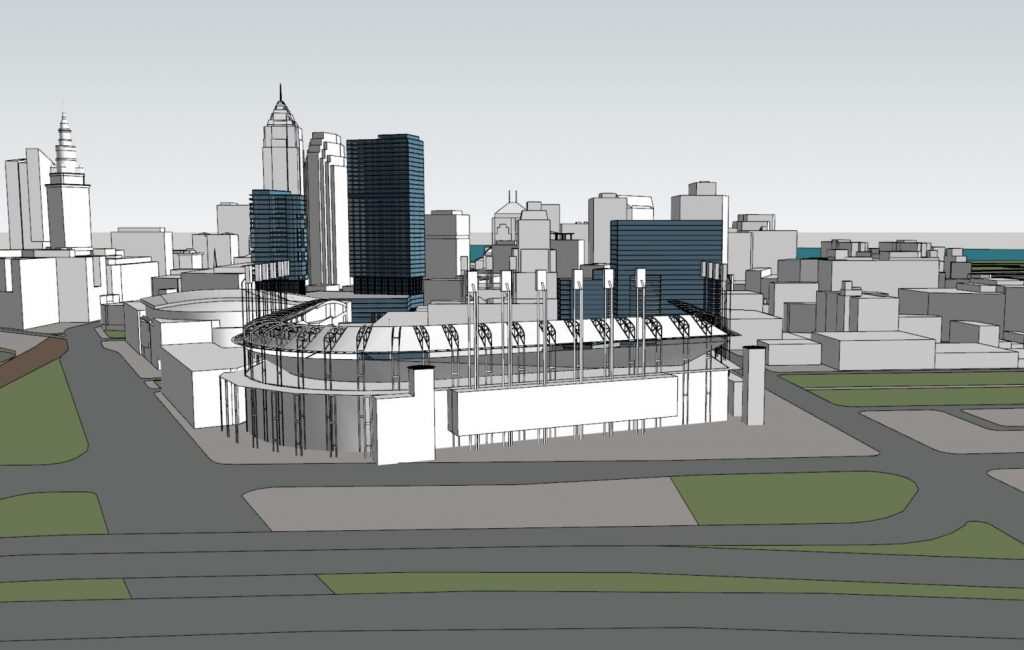House demo OK’d; Row on Garden tabled again
Different departments of the city of Cleveland are stretching a Lakewood-based real estate company, ALMiCO Group, with orders to stop and go on different aspects of its multi-phase development in the city’s Brooklyn Centre Historic District. Caught in this push-pull is a phase called Row on Garden, now planned as an 18-unit apartment building on Garden Ave.
The first phase of the development was completed in early 2024. ALMiCO Group opened the Lofts on Pearl, a redevelopment of the century-old Brooklyn Masonic Temple, 3804 Pearl Rd., into a 26-unit apartment complex with ground-floor commercial spaces. The Lofts on Pearl has since leased out, development team members said.
Thirteen months ago, on March 14, 2024, three old houses on Garden Avenue were approved for demolition by the Landmarks Commission while razing a fourth at 2902 Garden was tabled along with Row on Garden’s first iteration — a planned six-unit townhome development — intended to replace the old houses.
So Row on Garden was put on the back burner by ALMiCO Group while it focused on other aspects that were approved by the city — namely the Flats on Pearl, a new-construction, five-story building with 34 apartments above three ground-floor retail spaces at 3784 Pearl Rd.
Also, a proposed $20.7 million renovation of the historic Kerns Hall, 2604 Garden Ave., won a $596,903 State Historic Preservation Office tax credit in December 2024. Constructed in 1890, Kerns Hall is a three-story mixed-use building that will be renovated with local retail, a restaurant and community spaces.
But on Dec. 11, 2024, the city’s Building Department condemned the 135-year-old house at 2902 Garden, forcing ALMiCO Group to turn its attention back to the Row on Garden. By this time, the construction materials market had changed to where for-sale townhomes in this neighborhood no longer made economic sense to ALMiCO Group’s principal Kostas Almiroudis.
So while the Landmarks Commission on Friday reluctantly approved the demolition of 2902 Garden, while accusing ALMiCO Group of “demolition by neglect,” it again tabled the Row on Garden development. It also recommended a study subcommittee be formed to see how the plans could better fit in with its neighborhood.
Project architect Jill Brandt defended her client by saying that the ALMiCO Group had made attempts to board up and otherwise protect 2902 Garden over the past year. Five complaints were filed with the city since December about the vacant property being open to entry, according to Building Department records.
“There’s been squatters and people in the neighborhood that have been breaking windows, tearing off the plywood and they actually took some cornerstones out of the foundation to get in,” Brandt said. “So the building, even though he (Almiroudis) keeps going back and boarding it up, it’s just exposed to elements and quite frankly, unsafe.”
She said the cost estimate to restore the house was very high and the development team said it was not cost-effective to renovate for the resale prices being offered in the Brooklyn Centre neighborhood. So ALMiCO Group considered different alternatives for developing the north side of Garden.

Awaiting imminent demolition is the 135-year-old house at 2902 Garden Avenue. City officials said the house was unsafe but accused the owner of demolition by neglect. The owner’s architect defended her client, saying that squatters removed boards on windows and even stone blocks to get into the basement (Brandt).
“There is need for apartments rather than the townhomes,” Brandt said. “So at this point in time we are proposing is converting the floor plans of the six three-story townhomes so that each floor would be an apartment unit.”
To step down from the commercial buildings fronting Pearl to the single-family residential to the west, the new design kept the townhouse appearance with the gabled roofs which is similar to other nearby houses. And Row on Garden would also have traditional brick and lap siding.
“Staff feels the change from the townhomes to the apartments is significant enough that it deserves a bit more time and study,” said Landmarks Commission Secretary Dan Musson. “The current proposal certainly has elements of the former proposal but it’s a considerably different function.”
Almiroudis told commission members that his firm did market studies showed single-family homes “don’t work” for that area. He said that building three-story townhomes would require selling them for $750,000 to earn a decent return. If they were reduced to two floors and about 1,650-1,700 square feet each, they could be sold for about $500,000 each.
“It’s not worth putting a project together to make 10-grand ($10,000) per house,” Almiroudis said. “I mean, I love to restore the neighborhood, but I have kids to feed as well.”
“Anything else beyond that point — single-family sales, townhome sales, so on and so forth, with the prices going up on materials and I don’t know what’s going to happen with the tariffs, and with interest rates at eight or nine percent — this is not going to happen for the next 45 years if we don’t go along with it in the next nine to 12 months,” he added.
The commission voted to form a subcommittee to work on reviewing and recommending design options with the developer. The subcommittee will meet at a conference table and sketch out some ideas but would result in design-by-committee. But the goal is to provide direct feedback, Musson said.
“I personally don’t object to the revision of use based on what you’re building adjacent to it,” said Landmarks Commission Chair Julie Trott. “I think we just want to look at the architecture to make sure that it blends with the neighborhood appropriately for that new use because this is a drastic change.”
END






